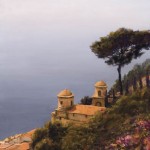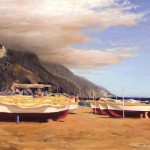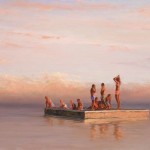William Berra infuses his paintings with emotive color and life
By Reed Glenn

William Berra, Diving Platform, Reflections, oil, 30 x 40.
High on the tawny ridges above Santa Fe, NM, an eagle-eye view of endless blue sky, green farmlands, and amethyst peaks extends all the way to Colorado. Painter William Berra’s home and studio perch on just such an aerie. “Here in northern New Mexico, the landscape and the changing skies are a constant source of pleasure and inspiration,” says Berra. “From my studio north of Santa Fe in the foothills of the Sangre de Cristo Mountains, I can watch the weather as it moves across the Rio Grande Valley and see the exquisite sunsets develop over the Jemez Mountains. My everyday life is really part of my painting.”
Along with the enthralling New Mexico landscape, Berra’s everyday life includes trips to Europe and annual visits to the Hawaiian islands. His latest visit there opened up a whole new motif for him. “I was sketching on Kahala Beach on the island of Oahu when a group of locals showed up and started using a diving platform just offshore. What I had been working on was dull compared to what was unfolding in front of me—all of their activity, the patterns they made, and the reflections in the comparatively still water. So I started sketching them as a study for a bigger painting, and it became a whole series.” Berra says he was captivated by what seemed like a stage set, including the interaction of the kids and the very abstract seascape around them. “Now I’m searching the country for diving platforms, going to lakes and ponds.”
This isn’t the first time an unexpected subject has become a series of paintings. Take the lowly fence post. “When I first came to New Mexico I painted the landscape a lot,” says Berra, who moved there in 1976. “I painted wandering junipers. Then I got into clouds. But every time I wanted to paint something, a fence post got in the way. So then I did a whole fence-post series.”

William Berra, An Afternoon in Ravello, oil, 40 x 30.
Once Berra is inspired by a new motif, a series might continue for four to five years or more. Another one of his series is the rustic adobe churches of northern New Mexico. “I painted a great many of them about 15 years ago, and now I’m enjoying revisiting, reinvestigating, and repainting them,” he says.
Berra was born in York, PA. No family artists inspired or influenced his choice of profession. “I was pretty much on my own,” he says, though his family supported his artistic leanings. In school he excelled in drawing rather than academics, and by high school he was copying the Neo-Classic painters and old masters. “I’ve been creating visual art continually since childhood, but my real career as an artist began when a friend invited me to take classes at the local art academy [York Academy of Art] when I was 16.”
After graduating from high school, Berra attended the Maryland Institute of Art and encountered the work of a group of 19th-century Italian plein-air painters known as the Macchiaiolis. Macchie is Italian for patches or spots, and the Macchiaiolis, the precursors of the Impressionists, believed that light and shadow defined a work of art. The phrase darsi alla macchia also meant, idiomatically, to hide in the bushes or scrubland, which was where these artists painted. As part of their rebellion against the artistic traditions of the day, and to facilitate the mixing of pigments in the outdoors, they applied an orange undercoat on their canvases, then painted in patches of color on top of it. This gave the finished painting a warm, luminous glow. Berra adopted this technique, which he still employs today. His entire canvas gets the orange undercoat, even the areas that will become white clouds and blue skies.
During college Berra also became captivated by the work of Jean-Baptiste-Camille Corot. Corot combined plein-air and studio work, which was unusual at a time when artists more typically took the “Grand Tour” of Europe and hunkered down in front of historic architectural monuments for months at a time. Unlike the other artists of the day, Corot chose different angles from which to capture these sites—off to the side, for example—while other painters portrayed standard frontal views. Corot made sketches and finished the paintings back in his studio, just as Berra does today.
After a year at the Maryland Institute, Berra set out to travel and paint, emulating the artists who inspired him. He spent several years exploring the United States, living in San Francisco, Baltimore, Oregon, and Vermont and working odd jobs to support himself while he painted in each locale. “Travel is one of the greatest sources of inspiration for me,” says Berra.
In 1976 he and an artist friend traveled out west, and Berra fell in love with New Mexico. He says they were really just passing through, but deciding to move to Santa Fe, with its many galleries, culture, history, and spectacular scenery, “was a no-brainer.” In 1978 Berra’s work was accepted into the biennial show at the New Mexico Museum of Art. Soon after, a local gallery began showing his paintings, and his career was officially launched.

William Berra, Colors of Positano, oil, 24 x 48.
So many notable artists have portrayed the Southwest’s spectacular scenery that Berra says “it was nice coming to the Southwest and seeing the work of artists who had painted the same landscape I was living in, seeing their interpretations.” He was particularly inspired by the work of Victor Higgins, a member of the famed Taos Art Colony formed in the early 20th century. These European-trained artists introduced the area’s wonders to the American public and the world.
But ultimately, Berra says, “My heroes were Corot and Frederic Church. Both set out to do similar things. They did what their teachers had taught them, which was to go to nature. It was the beginning of artists actually going out and studying nature—getting close up to capture the atmospheric conditions and other information they couldn’t get in the studio.”
Landscape painters of that time benefited from two major technical advances. One was the introduction of paint in tubes, which could be easily transported. Previously, plein-air painters had to assemble their palettes in their studios before venturing into the great outdoors. The other advance was the creation of the cadmium colors. These vivid reds, oranges, and yellows allowed Church to paint brilliant sunsets. “You can imagine the enthusiasm of having a material like that to work with,” Berra says. “It was a great gift. A lot of things we take as commonplace now were new then. Not much has changed since then [for painters] except transportation.”
Church was a student of Thomas Cole, founder of the Hudson River School, a 19th-century American art movement characterized by romanticized but realistic and detailed renderings of the American landscape. To find scenes to paint, Church traveled widely, including trips to Europe, the Middle East, and South America, where he produced paintings of the Andes and tropical scenes, even bringing back South American plants to enhance his exhibitions.
In 2000, inspired by his heroes, Berra traveled to Europe. “I decided that I’d go to Rome and hunt out the vidutis. When artists like Corot did the Grand Tour, they went to Rome and painted the “common views,” known as vidutis—somewhat like a postcard or snapshot of a popular site,” says Berra. In Italy Berra also painted along the Amalfi Coast, and in Greece he painted island scenes.
Berra continues all of these 19th-century traditions with a 21st-century outlook. DIVING PLATFORM, REFLECTIONS, one of his Hawaii paintings, “conveys a romantic image of a moment of happy isolation, a moment when the beauty of the human figure is set off by the stark abstraction of nature,” he says. “The people in this painting form a small society floating in abstract space. They are isolated in their own reality, intent on their own relationships with no interruption from the outside world. The atmosphere of the sunset sky and the way it reflects in the water gives a mood to the figures.”
Over the past 10 years, Berra says, his style has changed somewhat in that he has developed his figures more. “They’re not as blocky,” he notes. “Also, I’m more concerned with depth. Before I was doing flat patches of color; now I’m interested in rendering depth and atmosphere.” DIVING PLATFORM, REFLECTIONS represents a new phase in his figurative work. “This painting is the next progression from the landscape and figurative work that I’ve done,” he says. “Elements that I’ve long worked with, I am now combining in different ways.”
In the end, what is it that stirs Berra to paint? “The sheer pleasure of painting itself!” he exclaims. “I am inspired by the joy and beauty of the world around me. There’s always something that needs to be said.”
Dossier
Representation
Nedra Matteucci Fine Art, Santa Fe, NM; Nedra Matteucci Galleries, Santa Fe, NM; Westbrook Galleries, Carmel, CA; Greenhouse Gallery of Fine Art, San Antonio, TX; The Sylvan Gallery, Charleston, SC; Galleria Silecchia, Sarasota, FL.
Featured in August 2010
- William Berra, An Afternoon in Ravello, oil, 40 x 30.
- William Berra, Colors of Positano, oil, 24 x 48.
- William Berra, Diving Platform, Reflections, oil, 30 x 40.








